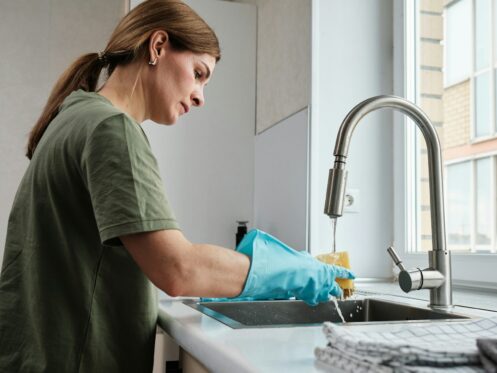A slow drain can be a frustrating issue, disrupting your daily routine and creating potential messes in your home. Simple DIY methods can often fix this problem without the need for a plumber. Whether it’s using basic household items or tools, you’ll find that many solutions are straightforward yet effective.
For instance, techniques like baking soda and vinegar can work wonders in breaking down small blockages. Regular cleaning and maintenance can prevent clogs from becoming a bigger headache. If you find yourself battling with persistent slow drains, knowing when to call professionals like Splash Plumbing can also save you time and stress.
Remember, you don’t need to feel helpless when faced with slow drains. With the right approach and a bit of effort, you can restore your plumbing to its efficient state. Let’s explore some practical methods to tackle slow drains effectively.
Understanding Drain Dynamics
Navigating the complexities of your home’s plumbing can help you diagnose and address slow-draining issues effectively. Understanding the types of drains and the factors influencing their performance is essential for maintaining an efficient plumbing system.
Types of Drains and Common Issues
Different sinks in your home, such as the bathroom sink and kitchen sink, can face unique challenges. Clogs often stem from the accumulation of hair, grease, and food particles. The P-trap in your sink is a common area where obstructions appear. Regular cleaning can prevent persistent slow-draining conditions.
Common issues include:
- Blocked P-trap: Clear by removing it for thorough cleaning.
- Debris buildup: Use a mixture of baking soda and vinegar to break down material.
- Ventilation problems: Ensure vents are unblocked to allow proper airflow.
Addressing these issues can restore proper drainage and extend the life of your plumbing system.
The Impact of Hard Water and Mineral Deposits
Hard water is a considerable factor in slow drains. It contains high levels of minerals like calcium and magnesium. These minerals can lead to mineral deposits that build up inside pipes, narrowing the passage for water flow.
Consider these effects:
- Reduced water flow: Mineral buildup can create blockages, especially in older plumbing systems.
- Frequent clogs: Hard water deposits can catch debris, leading to recurring issues in your kitchen sink or bathroom sink.
- Pipe corrosion: Over time, these deposits may cause damage and lead to leaks.
To combat these problems, consider installing a water softener. This can help reduce mineral buildup and maintain your plumbing’s efficiency. If you experience ongoing issues, consult Splash Plumbing for professional assistance in your area.
Initial Inspection and Simple Fixes
When facing a slow drain, the first steps involve thorough inspection and basic troubleshooting. Identifying whether you’re dealing with a partial or full clog can guide your approach. Often, simple fixes can resolve the issue before needing professional help.
Identifying Partial vs. Full Clogs
Start by determining if the blockage is a partial or full clog. A partial clog typically allows some water to drain slowly, while a full clog stops water completely. You may notice water pooling in the sink or toilet.
Check visible areas such as the sink stopper, overflow opening, and drain cover for any debris. Common culprits include hair, soap scum, and food particles. A quick visual inspection can save you time and effort in identifying the issue.
Clearing Obstructions Manually
If you suspect a clog, try to clear it manually for immediate results. Start by removing the sink stopper if your sink has one. This will give you better access to the drain. Use your fingers or a rag to extract visible debris.
For deeper blockages, a plunger can be effective. Ensure you create a good seal over the drain and plunge vigorously. If this doesn’t work, consider using a drain snake to reach stubborn obstructions.
For minor clogs, combining hot water with baking soda and vinegar can help dislodge buildup. Always be cautious with homemade solutions and avoid harsh chemicals. If you’re still stuck, don’t hesitate to call in experts like Splash Plumbing to assist you.
Natural Cleaning Techniques
You can effectively address slow drains using natural cleaning techniques that do not rely on harsh chemicals. These methods are simple, eco-friendly, and often use common household items.
Using Baking Soda and Vinegar
This combination is widely recognized for its ability to clean drains. Start by pouring 1/2 cup of baking soda down the slow sink drain. Follow this with 1/2 cup of white vinegar. You may hear fizzing as the two react, which helps to break down grease and food scraps. Allow the mixture to sit for about 30 minutes to loosen any buildup. After waiting, flush the drain with boiling water to clear away any remaining debris. This method is effective for light clogs and helps maintain clear pipes, reducing future issues. For stubborn clogs, you might need to repeat the process or consider contacting Splash Plumbing if the problem persists.
The Boiling Water Method
Using boiling water is a straightforward way to address minor clogs caused by grease and soap buildup. Begin by boiling a kettle of water. Slowly pour the hot water into the drain, allowing it to wash away accumulated residue. This method works best when the clog consists mostly of grease. If necessary, you can repeat this process a few times for tough blockages. It’s a quick and effective approach that can keep your pipes clean. Remember that continuous hot water usage helps maintain your plumbing, improving its longevity and efficiency. If you find persistent slow drains, don’t hesitate to reach out to Splash Plumbing for professional assistance.
Advanced Clearing Methods
When facing a stubborn slow drain, advanced techniques can provide effective solutions. Utilizing tools like plungers and drain snakes can help clear blockages with precision. This section focuses on how to plunge effectively and how to employ a drain snake for optimal results.
Plunging Effectively
To tackle a slow drain using a plunger, select a cup plunger, which is most effective for sinks and tubs. Start by filling the sink or tub with enough water to cover the plunger’s cup.
- Create a Seal: Position the plunger over the drain and press down to form a seal.
- Plunge: Using quick, firm thrusts, push down and pull up for about 15-20 seconds. This action creates pressure that can dislodge clogs.
- Test Drainage: Remove the plunger and observe if water drains properly. If not, repeat the process.
For persistent blockages, consider employing a professional plumber for advice. A skilled plumber can extend beyond basic methods and ensure your plumbing remains in excellent condition.
How to Employ a Drain Snake
A drain snake, or auger, is a flexible tool that can reach deep into pipes to dislodge clogs. Here’s how to effectively use one:
- Insert the Snake: Feed the end of the snake into the drain until you feel resistance. This indicates it has reached the blockage.
- Crank the Handle: Turn the handle clockwise. This action helps the snake navigate through bends and twists in the pipe.
- Break Up the Clog: Continue cranking until you feel the obstruction give way. Ensure you pull the snake out slowly to avoid damaging the pipes or scattering debris.
If you’re unsure or uncomfortable using a drain snake, you can always contact Splash Plumbing for assistance. Their expertise ensures that your drainage issues are resolved quickly and efficiently.
Maintenance and Prevention
Maintaining clear drain pipes is essential to prevent slow drains and clogs. Regular cleaning and using devices to catch hair and debris can keep your plumbing system functioning optimally.
Regular Cleaning
You should perform regular cleaning of your drains to prevent buildup. For sinks, use a mixture of baking soda and vinegar to help break down minor clogs. After letting it sit for about 15 minutes, flush with hot water.
Consider using a vacuum designed for wet debris to remove hair from the drain. Wearing gloves can protect your hands while you clear the p-trap or the u-shaped pipe under your sink. Additionally, avoid putting items like toothpaste or grease down the drain, as these can lead to significant blockages over time.
Installing Hair and Debris Catchers
Installing hair and debris catchers is a proactive way to prevent clogs. These simple devices fit over your drain opening and catch hair and larger particles before they enter the system.
For tubs and sinks, consider using a Zip-It tool to manage hair that has already accumulated. Regularly check and clean these catchers to ensure they are effective. This practice not only helps maintain function but also reduces the need for extensive cleaning later.
Keeping your drains clear is much easier with these preventative measures, and if you need professional assistance, Splash Plumbing can help with any plumbing issues that arise.
Frequently Asked Questions
Dealing with a slow drain can be frustrating, but understanding effective solutions can help you resolve the issue quickly. Below are answers to common questions about fixing slow drains in various areas of your home.
What steps can I take to clear a slow draining sink?
Start by using a cup plunger to create pressure and remove clogs. If that doesn’t work, mix equal parts of baking soda and white vinegar in the drain. Let it sit for about 15 minutes, then flush with hot water.
What are effective home remedies for a slow draining bathtub?
For a bathtub, you can use a combination of baking soda and vinegar followed by hot water. Additionally, try pouring boiling water directly into the drain to help break down any soap scum or hair that may be causing the blockage.
How can I fix a slow draining shower without professional help?
Begin by clearing the shower drain cover and removing any visible debris. You can then use a wet/dry vacuum to suck out hair and other materials. If the problem persists, a baking soda and vinegar solution can help.
What causes a kitchen sink to drain slowly and how can it be fixed?
Common causes include food particles, grease buildup, or a clogged trap. To fix it, try using a mixture of baking soda and vinegar or a drain snake to remove clogs. If that doesn’t work, cleaning out the trap may be necessary.
How do you handle a slow draining bathroom sink with no visible blockage?
If you can’t see any blockage, consider checking the P-trap under the sink; it may be clogged. You can also pour a mixture of baking soda and vinegar down the drain, followed by hot water to clear potential issues.
What are the best solutions to resolve main drain sluggishness?
For main drain issues, consider using a plumbing auger or a hydro jetting service to clean the pipes effectively. Regular maintenance and routine inspections by professionals like Splash Plumbing can also prevent future slow drainage problems.












